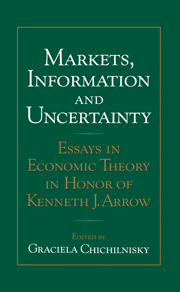Book contents
- Frontmatter
- Contents
- Preface
- List of contributors
- Section I Information and markets
- Section II Uncertainty and finance
- Section III Market externalities and justice
- 8 Moral hazard and independent income in a modern intertemporal-equilibrium model of involuntary unemployment and mandatory retirement
- 9 On the optimal schedule for introducing a new technology, when there is learning by doing
- 10 Price and market share dynamics in network industries
- 11 Exchange in a network of trading posts
- 12 Equilibrium market formation causes missing markets
- 13 Toward a general theory of social overhead capital
- 14 On population externalities and the social rate of discount
- 15 Trade and Welfare
- 16 History as a widespread externality in some Arrow–Debreu market games
- 17 Redistribution by a representative democracy and distributive justice under uncertainty
- Author index
- Subject index
11 - Exchange in a network of trading posts
Published online by Cambridge University Press: 05 December 2011
- Frontmatter
- Contents
- Preface
- List of contributors
- Section I Information and markets
- Section II Uncertainty and finance
- Section III Market externalities and justice
- 8 Moral hazard and independent income in a modern intertemporal-equilibrium model of involuntary unemployment and mandatory retirement
- 9 On the optimal schedule for introducing a new technology, when there is learning by doing
- 10 Price and market share dynamics in network industries
- 11 Exchange in a network of trading posts
- 12 Equilibrium market formation causes missing markets
- 13 Toward a general theory of social overhead capital
- 14 On population externalities and the social rate of discount
- 15 Trade and Welfare
- 16 History as a widespread externality in some Arrow–Debreu market games
- 17 Redistribution by a representative democracy and distributive justice under uncertainty
- Author index
- Subject index
Summary
Foreword
I first met Kenneth Arrow in 1965, half a lifetime ago. As an undergraduate at Stanford University, I took Ken's graduate advanced mathematical economics course. It was a view into another world, where the precision of mathematics had a compass limited only by imagination. The focus of the course was mathematical general equilibrium theory, presented in part from the working manuscript of Arrow and Hahn's General Competitive Analysis (as Ken lectured from the manuscript the ink on some pages was still wet). As the quarter progressed, I discussed the course's required term paper with Ken (then “Prof. Arrow”) and expressed annoyance with the convexity assumption on preferences in Theory of Value. Ken referred me to a well chosen bibliography including Aumann's measure theoretic work (in working paper form), Shapley and Shubik on approximate cores, and the geometric discussions of J. Rothenberg. He did not suggest that the project under discussion was too ambitious. The term paper became an early draft of my first published work “Quasi-equilibria in markets with non-convex preferences.” The final version benefited from detailed critical correspondence from Robert Aumann and the mathematical innovations of Lloyd Shapley and John Folkman communicated by Shapley. From that beginning there was no turning back. Pure mathematical economic theory seemed the most intellectually challenging and rewarding pursuit one could undertake.
- Type
- Chapter
- Information
- Markets, Information and UncertaintyEssays in Economic Theory in Honor of Kenneth J. Arrow, pp. 216 - 234Publisher: Cambridge University PressPrint publication year: 1999
- 6
- Cited by



